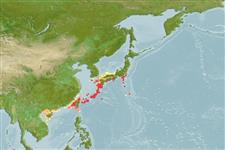>
Eupercaria/misc (Various families in series Eupercaria) >
Labridae (Wrasses) > Corinae
Etymology: Halichoeres: Greek, als, alis = salt + Greek, choiros = pig (Ref. 45335); orientalis: Named in reference to its occurrence in southern Japan and Taiwan (Ref. 31549).
More on author: Randall.
Environment: milieu / climate zone / depth range / distribution range
Sinh thái học
Biển Cùng sống ở rạn san hô; Mức độ sâu 2 - 30 m (Ref. 31549). Subtropical
Northwest Pacific: southern Japan and Taiwan.
Bộ gần gũi / Khối lượng (Trọng lượng) / Age
Maturity: Lm ? range ? - ? cm
Max length : 7.6 cm SL con đực/không giới tính; (Ref. 31549)
Short description
Hình thái học | Sinh trắc học
Các tia vây lưng cứng (tổng cộng): 9; Các vây lưng mềm (tổng cộng): 12; Tia cứng vây hậu môn 3; Tia mềm vây hậu môn: 12; Động vật có xương sống: 25. Each lateral line scale with 2-4 tubules; without scales on cheek or opercle; without scales basally on dorsal or anal fins; a single pair of stout canines anteriorly in each jaw; a strong canine at corner of mouth; 9th dorsal spine longest, 2.75-3.1 in HL; green with 4 longitudinal salmon pink to orange bands on head, the 2nd and 3rd passing through eye, the 3rd bifurcating on opercle; a small vertically elongate black spot behind eye; upper 3 bands of head continuing as stripes anteriorly on body, and 2 more commencing from beneath pectoral fin, these stripes variously breaking into segments and forming 6 groups of irregular spots dorsally on body, the 2nd group in a dusky blotch; presumed male with this blotch black and containing small irregularly yellow spots; another presumed male phase blackish posteriorly to a vertical through base of 6th dorsal spine.
Life cycle and mating behavior
Chín muồi sinh dục | Sự tái sinh sản | Đẻ trứng | Các trứng | Sự sinh sản | Ấu trùng
Distinct pairing during breeding (Ref. 205).
Randall, J.E., 1999. Halichoeres orientalis, a new labrid fish from southern Japan and Taiwan. Zool. Stud. 38(3):295-300. (Ref. 31549)
IUCN Red List Status (Ref. 130435)
Threat to humans
Harmless
Human uses
Thêm thông tin
Age/SizeSự sinh trưởngLength-weightLength-lengthLength-frequenciesSinh trắc họcHình thái họcẤu trùngSự biến động ấu trùngBổ xungSự phong phúBRUVS
Các tài liệu tham khảoNuôi trồng thủy sảnTổng quan nuôi trồng thủy sảnCác giốngDi truyềnElectrophoresesDi sảnCác bệnhChế biếnNutrientsMass conversion
Các công cụ
Special reports
Download XML
Các nguồn internet
Estimates based on models
Preferred temperature (Ref.
123201): 21.4 - 27.1, mean 24.9 °C (based on 176 cells).
Phylogenetic diversity index (Ref.
82804): PD
50 = 0.5000 [Uniqueness, from 0.5 = low to 2.0 = high].
Bayesian length-weight: a=0.00955 (0.00451 - 0.02020), b=3.09 (2.92 - 3.26), in cm total length, based on LWR estimates for this Genus-body shape (Ref.
93245).
Mức dinh dưỡng (Ref.
69278): 3.3 ±0.5 se; based on size and trophs of closest relatives
Thích nghi nhanh (Ref.
120179): Chiêù cao, thời gian nhân đôi của chủng quần tối thiểu là dưới 15 tháng (Preliminary K or Fecundity.).
Fishing Vulnerability (Ref.
59153): Low vulnerability (10 of 100).
Nutrients (Ref.
124155): Calcium = 86 [38, 193] mg/100g; Iron = 0.886 [0.457, 1.899] mg/100g; Protein = 19 [16, 21] %; Omega3 = 0.265 [0.138, 0.510] g/100g; Selenium = 10.1 [4.3, 22.6] μg/100g; VitaminA = 113 [30, 544] μg/100g; Zinc = 1.48 [0.87, 2.62] mg/100g (wet weight);
